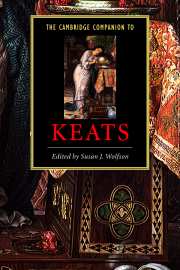Book contents
- Frontmatter
- 1 The politics of Keats’s early poetry
- 2 Endymion’s beautiful dreamers
- 3 Keats and the “Cockney School”
- 4 Lamia, Isabella, and The Eve of St. Agnes
- 5 Hyperion, The Fall of Hyperion, and Keats’s epic ambitions
- 6 Keats and the ode
- 7 Late lyrics
- 8 Keats’s letters
- 9 Keats and language
- 10 Keats’s sources, Keats’s allusions
- 11 Keats and “ekphrasis”
- 12 Keats and English poetry
- 13 Byron reads Keats
- 14 Keats and the complexities of gender
- 15 Keats and Romantic science
- 16 The “story” of Keats
- 17 Bibliography and further reading
- Index
11 - Keats and “ekphrasis”
Published online by Cambridge University Press: 28 May 2006
- Frontmatter
- 1 The politics of Keats’s early poetry
- 2 Endymion’s beautiful dreamers
- 3 Keats and the “Cockney School”
- 4 Lamia, Isabella, and The Eve of St. Agnes
- 5 Hyperion, The Fall of Hyperion, and Keats’s epic ambitions
- 6 Keats and the ode
- 7 Late lyrics
- 8 Keats’s letters
- 9 Keats and language
- 10 Keats’s sources, Keats’s allusions
- 11 Keats and “ekphrasis”
- 12 Keats and English poetry
- 13 Byron reads Keats
- 14 Keats and the complexities of gender
- 15 Keats and Romantic science
- 16 The “story” of Keats
- 17 Bibliography and further reading
- Index
Summary
Ekphrasis] from ekphrazein: to speak out, to tell in full; an extended and detailed literary description of any object, real or imaginary.
One morn before me were three figures seen, With bowed necks, and joined hands, side-faced; And one behind the other stepp’d serene, In placid sandals, and in white robes graced: They pass’d, like figures on a marble urn, When shifted round to see the other side; They came again; as when the urn once more Is shifted round.
Keats, Ode on Indolence 1–8To say that Keats was fascinated by art approaches understatement. The poetry of that fascination is unequivocal. From the early sonnet On Seeing the Elgin Marbles, to the sculptured figures of the Hyperion poems and the odes of 1819, Keats returns to the world of art, haunting its forms in return for the ways in which those forms haunt his poetics. Still other poems include ekphrastic elements: On a Leander, his verse-epistle to Reynolds, and Ode to Psyche. As readers have long recognized, Keats's poetry often takes the mode of ekphrasis, the verbal or rhetorical description of artwork: a funerary urn, the Elgin Marbles, and typically, figures that Keatsian narrators present as though they were art objects - Madeline in The Eve of St. Agnes, the goddesses in Ode to Indolence, the fallen Titans of the Hyperion poems.
- Type
- Chapter
- Information
- The Cambridge Companion to Keats , pp. 170 - 185Publisher: Cambridge University PressPrint publication year: 2001
- 4
- Cited by



